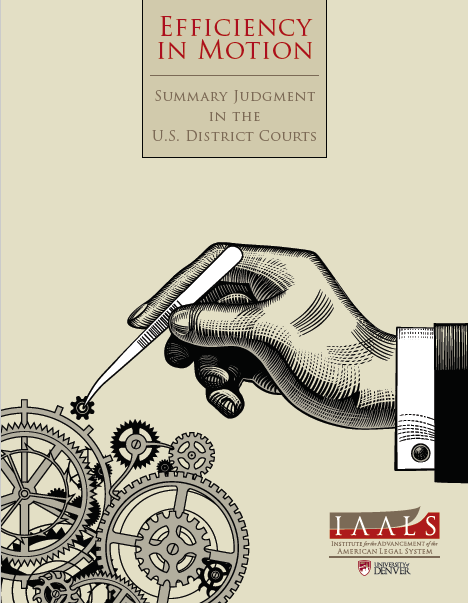IAALS Examines the Use of Summary Judgment in U.S. District Courts
 Much has been done over the past five years to address the cost and delay in the civil justice process, and much of that work has focused on discovery. Recognizing that there are equal challenges and opportunities for improvement in the area of motions practice, IAALS has undertaken a new project, titled Efficiency in Motion, focused on understanding the current motions landscape and issuing recommendations for improvement. As part of this project, IAALS announces the release of a new report, Efficiency in Motion: Summary Judgment in the U.S. District Courts. The report is intended to spark a national conversation about the current challenges of summary judgment, a process by which the court can rule on a portion or all of the issues in a case without proceeding to trial.
Much has been done over the past five years to address the cost and delay in the civil justice process, and much of that work has focused on discovery. Recognizing that there are equal challenges and opportunities for improvement in the area of motions practice, IAALS has undertaken a new project, titled Efficiency in Motion, focused on understanding the current motions landscape and issuing recommendations for improvement. As part of this project, IAALS announces the release of a new report, Efficiency in Motion: Summary Judgment in the U.S. District Courts. The report is intended to spark a national conversation about the current challenges of summary judgment, a process by which the court can rule on a portion or all of the issues in a case without proceeding to trial.
“Judges around the country point to excessive motion practice as a source of cost and delay in our system. Attorneys point to the lengthy time that judges take to rule on summary judgment motions. In response, there is a growing effort by judges, and some attorneys, to make the process more efficient,” said Brittany Kauffman, who directs IAALS' work to reform the civil justice system. “What is clear from the findings of Efficiency in Motion is that summary judgment motions play an important role in resolving a significant number of federal civil cases in our system. District courts and individual judges are experimenting with innovative ways to streamline this process around the country, and our Efficiency in Motion project is focused on highlighting the current landscape and providing recommendations for improvement.”
This latest IAALS report is an important first step in understanding this current landscape and targeting areas for improvement. It offers a window into summary judgment practice in America’s federal courts and is intended to serve as the foundation for robust conversations about current practices. The study found that across the diverse sample of federal district courts, there is a statistically significant difference in terms of filing rate, length of motions and opinions, time to disposition, and time to ruling. These findings suggest the need for identifying and implementing best practices with the goal of greater uniformity and efficiency in our courts.
IAALS’ next step is to develop recommendations for reform based on this data and input from a broad base of stakeholders with different perspectives and experiences. The goal is to support implementation and real impact on the ground to save litigants both time and money.



